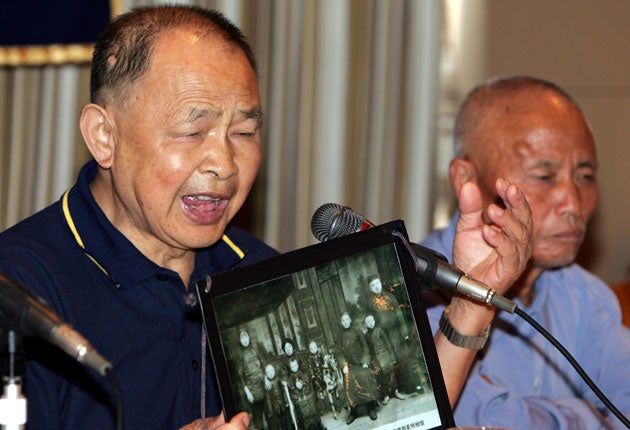Japan confronts truth about its germ warfare tests on prisoners of war
Search for corpses begins after nurse blows whistle on scandal

Your support helps us to tell the story
From reproductive rights to climate change to Big Tech, The Independent is on the ground when the story is developing. Whether it's investigating the financials of Elon Musk's pro-Trump PAC or producing our latest documentary, 'The A Word', which shines a light on the American women fighting for reproductive rights, we know how important it is to parse out the facts from the messaging.
At such a critical moment in US history, we need reporters on the ground. Your donation allows us to keep sending journalists to speak to both sides of the story.
The Independent is trusted by Americans across the entire political spectrum. And unlike many other quality news outlets, we choose not to lock Americans out of our reporting and analysis with paywalls. We believe quality journalism should be available to everyone, paid for by those who can afford it.
Your support makes all the difference.Scientists have begun digging for corpses at the site of a former Tokyo medical college allegedly used to conduct bio-warfare trials, reopening one of the darkest chapters of Japan's wartime past.
Activists campaigning for the excavation say that dozens of bodies were buried under the site at the end of the Second World War in an effort to cover up biological tests on prisoners, some dissected while still alive. "They dug a hole 10 metres deep and for a month after Japan's surrender they threw bodies into it," recalled Toyo Ishii, 88, a former nurse who began speaking out about what she saw after retiring. "The bodies included those of people who had been used in experiments to test the effects of germs."
Ms Ishii says she and others helped dump bodies and body parts, and were told to ignore questions about what took place there. An apartment building was built on top of the grave "so it would not be dug up again".
"One of the [former medical school] staff who knew the facts lived in the building to keep guard," she said.
The facility was reportedly linked to Unit 731 of the Japanese Imperial Army, then the most elaborate biological warfare programme ever created.
A centre south of Harbin in China turned typhoid, anthrax, smallpox, cholera and dysentery into mass-produced killers. Live prisoners were dissected to determine the effects of pathogens on the human body.
Yoshio Shinozuka, who was 16 when he was dispatched by Tokyo to help the Unit 731 scientists, remembers the first time he assisted in an experiment on one of the prisoners who were dubbed maruta, or logs. "I knew the Chinese individual we dissected alive," he recalls. "At the vivisection I could not meet his eyes because of the hate in them. He was infected with plague germs and... his face and body became totally black. Still alive, he was brought on a stretcher to the autopsy room, where I was ordered to wash the body. I used a rubber hose and a deck brush to wash him... The man's organs were excised one by one."
The results harvested from these experiments were, by 1940, being used to spread typhoid, cholera and plague across China. Soldiers dumped pathogens in rivers and water supplies. Fleas were cultivated to carry the plague, then dumped over Chinese villages. The effectiveness of the experiments is widely disputed, but some historians put the casualty count in the six-figure range.
After the war, the Japanese military scientists who had built the programme and boasted of its war-winning potential were given amnesty by the US occupation, in exchange for their research findings. "The value to the US of Japanese biological warfare data is of such importance to national security as to far outweigh the value accruing from 'war crimes' prosecution,'' wrote one US military scientist.
The military seal of approval meant immunity for the key figures, including the programme's architect, Shiro Ishii, who died of natural causes in Tokyo in 1959. Many had lucrative post-war careers in the medical industry.
Japan's high command ordered the dynamiting of Unit 731's Chinese facilities as the end of the war approached. Japanese governments have never officially acknowledged their existence, successfully fighting a 2002 demand for compensation by Chinese victims of the experiments. Health ministry officials refused requests from Chinese families who wanted DNA testing of bone fragments found nearby in 1989.
The Tokyo site would probably have remained undisturbed were it not for the efforts of Ms Ishii and local residents, who demanded the human remains be exhumed. Tokyo's metropolitan government wanted to turn the site, which housed much of the Imperial Army's main facilities, into a sports ground. For years, it argued with the health ministry over who was responsible for the actions of the old army.
Excavations were finally ordered five years ago by the government but were delayed while buildings on the site were demolished and residents rehoused. Officials are playing down expectations of a major revelation. "We are not certain if the survey will find anything," health ministry official Kazuhiko Kawauchi told the Associated Press.
But activists said the dig is very important. "It was a horrific war crime and deserves to be more widely known," said civil rights lawyer Keiichiro Ichinose, who helped lead the 2002 Chinese suit. "Japan must acknowledge its past before it can move forward."
Subscribe to Independent Premium to bookmark this article
Want to bookmark your favourite articles and stories to read or reference later? Start your Independent Premium subscription today.
Join our commenting forum
Join thought-provoking conversations, follow other Independent readers and see their replies
Comments